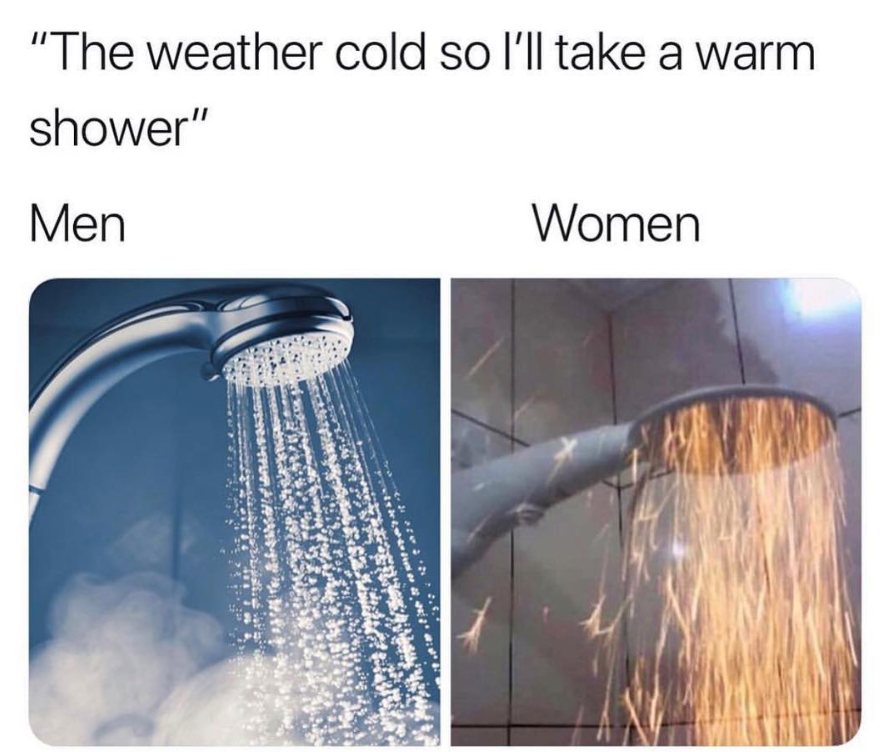If you’ve ever jumped into the shower right after your partner and wondered whether you’d accidentally stepped into a volcano, you’re not alone. That dramatic temperature swing has become a shared experience for couples everywhere. What one person calls a “warm” shower, the other might describe as an extreme heat challenge. The difference is real—and honestly, pretty hilarious. But beyond the memes and jokes, there’s some fascinating science behind this everyday phenomenon.

Let’s break down why men and women experience shower temperatures so differently, what the science says about it, and how couples can navigate this hot (literally) topic without burning bridges—or skin.
That Viral Meme Hit a Nerve (and Maybe a Sweat Gland)
You’ve probably seen it: a meme with two showerheads—one labeled “Men,” showing a pleasant stream of warm water, and the other labeled “Women,” with flames bursting out like a medieval torture device. It’s funny because it feels so true. Ask any man who’s stepped into a shower right after his wife or girlfriend—he’ll likely describe it as stepping into the fiery pits of hell.
But is it all exaggeration? Not entirely. There’s some biological and psychological truth to the humor.
Biology 101: Why Women Feel Colder Than Men
Let’s start with some basic physiology. Women tend to feel colder than men in the same room temperature environment. It’s not just a matter of preference—it’s about how their bodies are built. Women typically have a lower resting metabolic rate, meaning they generate less internal heat. They also tend to have more subcutaneous fat (fat stored under the skin) and less muscle mass, which contributes to their extremities—like hands and feet—getting colder more quickly.
So, what’s the easiest way to feel warm again? Crank up the heat in the shower. What feels comforting to women might feel unbearable to men.
Hormones Play a Role Too
Hormones, especially estrogen, affect how women’s blood vessels react to temperature. Estrogen can make blood vessels more sensitive, meaning a woman’s hands and feet might feel cold even when the rest of the body is comfortable. When you add in hormonal fluctuations from menstruation, stress, or even just a long day, it’s no wonder that hot showers become more than just a cleansing ritual—they’re a full-on emotional reset.
Men Prefer Function Over Steam Rooms
For most guys, a shower is a simple routine: hop in, get clean, get out. There’s no need to turn the bathroom into a sauna. Men, who usually have more muscle mass and higher metabolism, generate more body heat naturally. Super-hot water doesn’t just feel uncomfortable—it can actually make them overheat quickly.
In fact, many men enjoy cooler showers, especially after exercise or in the summer. Cold water has even been linked to health benefits like better circulation and mood improvement. So, for some, that chilly blast is more refreshing than painful.
The Daily Temperature Tug-of-War
For couples living together, this difference in shower temperature preference can become a real point of contention. It’s the classic “who showers first?” debate. Whoever goes in second often has to deal with a tub that’s either scalding or freezing by their standards. And yes, some households have ongoing negotiations about “letting the water cool off” before switching places.
These little battles might seem trivial, but they’re a surprisingly common source of friction. And that’s probably why so many people relate to the meme—it reflects a real-life issue in a humorous way.
How to Keep the Peace (and Your Skin Intact)
While you can’t change biology, you can find ways to compromise when it comes to shower temps. Here are a few ideas:
-
Use separate bathrooms if you’re lucky enough to have more than one. Sometimes, keeping shower time solo is the simplest fix.
-
Split the difference by letting the hot-shower fan go first, followed by the cool-shower partner.
-
Invest in a thermostatic shower valve, which lets each user preset their preferred temperature. It’s like a peace treaty for your bathroom.
-
Talk about it. Seriously. A quick, lighthearted conversation about preferences can go a long way in avoiding daily disagreements. Try saying, “I know you like your water to boil, but I’d like to keep my skin cells.”
Warm, Hot, or Lava—It’s All Relative
At the end of the day, “warm” is a subjective term. For some, it means comfortably cozy. For others, it’s borderline third-degree burns. But that’s the beauty of personal preferences—and relationships. Whether you’re someone who likes to feel the steam rise or someone who enjoys a brisk, refreshing rinse, there’s no wrong way to shower.
The key takeaway? Laugh about it, respect the difference, and maybe invest in better plumbing if you want to keep the peace. Because when it comes to relationships, it’s never really about the water—it’s about understanding what makes the other person comfortable and finding the middle ground (or in this case, the middle temperature).
So, the next time you argue over water temps, just remember: love might be warm, but everyone’s version of “warm” is a little different.





